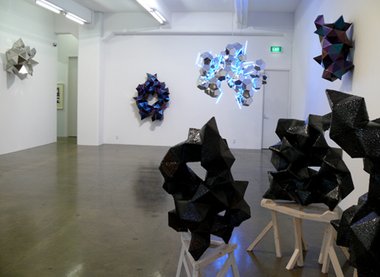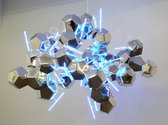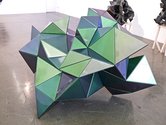John Hurrell – 6 July, 2010
Changing qualities of light dominate, particularly reflection, as you move between crystalline configurations, and with the smaller dark sculptures on very odd, comic, spindly wooden plinths, the work begins to allude to angular furniture, compact human bodies and a brightly illuminated domestic setting.
The last time I saw a show of Gregor Kregar’s stainless steel, pyramidal clusters it was in Bath St Gallery in Parnell and I, thinking of the reflective properties of the steel, commented on how a white walled gallery ambience makes them look bland in a way that an outdoor park environs - with its trees, sky and grass - never could.
At Gow Langsford Kregar now demonstrates the effects of light on his complex configurations of rippling, stacked up, triangular planes in a more pronounced way. He has four ways of thinking about the evanescent: firstly where the gallery’s fluorescent lights on the ceiling get optically broken up, the glowing pieces scattered in reflection; secondly where short tubes of light are positioned within the complex geometry of the metal sculpture, seemingly impaling it; thirdly where wonky circles of coloured neon tubing are positioned within skeletal webs of plastic sticks to imply planes and provide a reflective haze; and lastly where the metal planes themselves are painted with ‘chromescent’ (changeable) car colours, usually ‘Shot Silk’, which change from green to purple as you walk past.
Rather than thinking of the sculptures as separate entities, I prefer to think of this show as an unruly installation with various variations on a theme, and different hexagonal ribbony structures of different thicknesses. It is quite eccentrically awkward and not logically tight. Some sculptures are free standing, others are on walls, while others still are made of hefty matt ceramic balanced on bizarre skeletal wooden stools. So light is reflected, radiated, or absorbed into shadow and dull dark surfaces, while the geometric masses themselves vary from solid looking and shimmering to airy and suggested.
For the viewer moving through the space, the chromescent colour changes need concentration to notice, probably because the gallery is busy with objects and the hues’ tones are close. Changing qualities of light dominate, particularly its hue and reflected light patterns, as you move between crystalline configurations and then stand back. There are also the smaller ceramic sculptures on very odd, spindly wooden plinths, and with those the work begins to allude to angular furniture, compact human bodies and a brightly illuminated domestic setting.
In fact these dark fired shapes on peculiar stands bring an element of humour by virtue of their sheer nutty awkwardness.They are out of keeping with the lightness of the rest of the show, each being like two works forced together in a stack. Their teetering incongruity and raw ugliness is strangely appealing - resulting partially from the organic nature of the materials. These could be the basis for another exhibition in fact, one that rejects smooth surface and industrial sheen, that deconstructs sculpture’s plinths and investigates comic form.
John Hurrell








 Advertising in this column
Advertising in this column Two Rooms presents a program of residencies and projects
Two Rooms presents a program of residencies and projects



This Discussion has 0 comments.
Comment
Participate
Register to Participate.
Sign in
Sign in to an existing account.